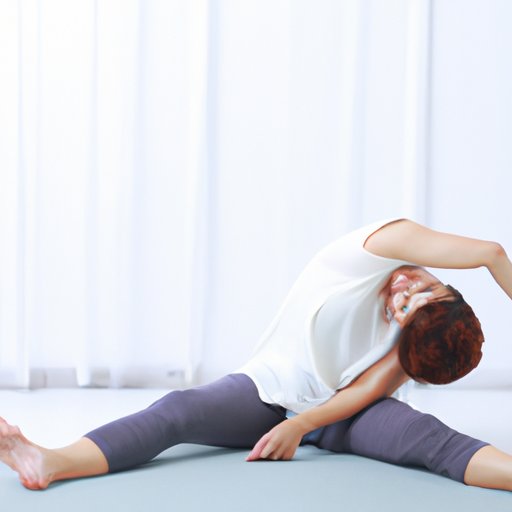
Introduction
Menstrual cramps are a common and uncomfortable reality for many women. While there are various remedies such as painkillers, hot compresses, and massages, exercise is often overlooked despite its numerous health benefits. Exercise has been shown to alleviate menstrual cramps, and it’s important to understand how to incorporate it into one’s routine. This article will delve into the benefits of exercise for menstrual cramps, exercise techniques and routines, types of exercises that can help, and yoga practices that can alleviate period cramps.
Research-backed Benefits of Exercise for Menstrual Cramps
Exercise has several benefits with regard to menstrual cramps. Studies have shown that moderate exercise during periods can alleviate cramps by increasing blood circulation, which relaxes muscles, and the release of endorphins, which are hormones that reduce pain perception. Exercise also helps in reducing stress levels that can affect the severity of menstrual cramps.
According to research, regular exercise can help in reducing the severity of menstrual symptoms, including cramps, bloating, and fatigue. For women who experience premenstrual syndrome (PMS), exercise can help in reducing the severity of symptoms. It’s essential to note that these benefits can only be achieved if women adopt a consistent exercise routine in their day to day lives.
No Pain, No Gain: Exercise Techniques and Tips
When it comes to alleviating period cramps, specific exercises can be more effective than others. It’s essential to know which exercises to do and how to do them correctly to obtain maximum benefits.
Exercises that target the abdominal muscles, including sit-ups, leg raises, and crunches, have been shown to help relieve menstrual cramps. Pelvic floor exercises and stretches can also ease period cramps. These exercises include Kegels, cat-cow stretches, and child’s pose.
It’s advisable not to over-exercise during periods, as it may increase the severity of menstrual cramps. Also, keeping up a regular exercise routine, even during non-period weeks, can significantly lessen the intensity and duration of menstrual cramps.
Stay Fit and Free From Menstrual Discomfort: Simple Exercise Routine
A daily exercise routine that women can follow can help alleviate menstrual discomfort and pain. The following routine can be done easily at home or the gym:
Warm-up: Start with light cardio, such as jogging or jumping jacks, for five minutes to increase your heart rate and warm up the muscles.
Crunches: Lie on your back and bend your knees, then lift your head and shoulders off the ground and hold for a few seconds before lowering back down. Perform 10-15 repetitions.
Kegels: Tighten your pelvic floor muscles and hold for five seconds before relaxing. Do ten repetitions.
Pelvic Tilts: Lie on your back with your knees bent and your feet flat on the ground, then lift your hips up, hold for a few seconds, and lower them back down. Perform ten repetitions.
Leg Raises: Lie on your back with legs extended upwards at a 90-degree angle; lower your legs to the ground and lift them back up again. Do ten repetitions.
Cool-down: Finish with stretching exercises, such as touching your toes or twisting your torso. Stretch for five to ten minutes to help keep your muscles loose and reduce the severity of menstrual cramps.
Exercise and Menstrual Health: Types of Exercises
Various types of exercises can improve menstrual health and alleviate discomforts. Cardio exercises such as running, cycling, or brisk walking can increase blood circulation, reduce stress levels, and promote overall well-being, all of which are helpful during periods and menstrual cramps. Resistance training can strengthen the pelvic muscles and abdominal muscles working to reduce the severity of menstrual pain.
Women can also benefit from low-impact exercises such as yoga, tai chi, and swimming. These exercises help relieve menstrual cramps and create better menstrual flow. Women can also pair exercise with other healthy habits, including nutrition, adequate sleep, and stress-reducing techniques.
Yoga and the Menstrual Cycle: Practices and Exercises
Yoga is an ancient Indian practice that can alleviate menstrual cramps and reduce the severity of PMS symptoms. In yoga, specific postures or poses can help address common menstrual cramp concerns.
Child’s Pose: Kneel on the floor and stretch your arms out in front of you. Lower your head to the floor and stretch your arms out, holding the position for up to one minute. This pose helps to relieve lower back pain.
Backward Bend: Start by standing with feet shoulder-width apart and your hands on your hips. Lean backward slowly, stretching your body into an arc, and hold for a few seconds before returning to the standing position. Repeat several times. This pose alleviates back pain and cramps.
Legs-Up-The-Wall Pose: Lie on your back with your legs resting against a wall, making an ‘L’ shape with your body. Hold this pose for up to five minutes to help improve blood circulation and relieve menstrual cramps.
Conclusion
In conclusion, exercise is a proven and natural way of alleviating menstrual cramps and other menstrual disorders. Regular and supervised exercise routines can help reduce the severity of menstrual pain, PMS symptoms, and improve overall menstrual health. Women who prioritize exercise in their menstrual care routine reap enormous benefits in the long term.
By following exercise techniques, simple routines, types of exercises, and yoga practices, women can improve their menstrual health and alleviate menstrual cramps discomfort. Women should strive to take care of themselves through exercise, prioritize self-care, and commit themselves to improving their menstrual health.





